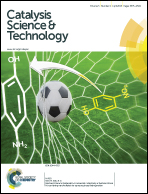Influence of structural and electronic properties of organomolybdenum(ii) complexes of the type [CpMo(CO)3R] and [CpMo(O2)(O)R] (R = Cl, CH3, CF3) on the catalytic olefin epoxidation†
Abstract
Six compounds of the type [CpMo(CO)3R] (R = Cl (1), CH3 (2), CF3 (3)) and [CpMo(O2)(O)R] (R = Cl (4), CH3 (5), CF3 (6) (Cp = η5-cyclopentadienyl)) have been synthesised and characterised. The crystal structures of [CpMo(CO)3CF3] and [CpMo(O2)(O)CF3] are compared to their literature known chloro and methyl derivatives. The influence of the groups R on the performance as epoxidation catalysts is examined. DFT calculations, IR-spectroscopy and X-ray crystallography help to explain differences in reactivity and enable a rational design of active molybdenum tricarbonyl and oxo-peroxo complexes.
![Graphical abstract: Influence of structural and electronic properties of organomolybdenum(ii) complexes of the type [CpMo(CO)3R] and [CpMo(O2)(O)R] (R = Cl, CH3, CF3) on the catalytic olefin epoxidation](/en/Image/Get?imageInfo.ImageType=GA&imageInfo.ImageIdentifier.ManuscriptID=C4CY01604A&imageInfo.ImageIdentifier.Year=2015)

 Please wait while we load your content...
Please wait while we load your content...